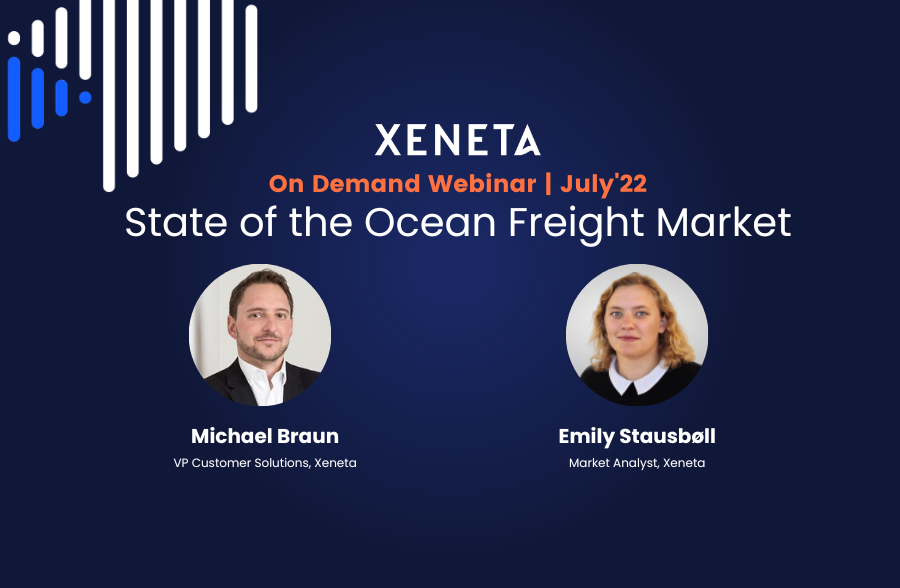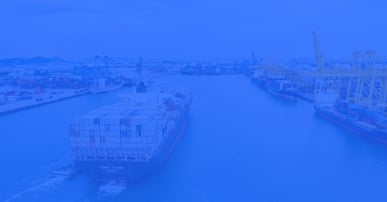Despite a degree of macro-economic uncertainty clouding the horizon, all major trades saw prices moving up, with some corridors showing significant gains. Is this growth sustainable? Is there an end in sight? How do falling spot rates and looming industrial action at major ports play a role now heading into the tender season?
Tune in to the latest episode of our leading monthly 'State of the Market' webinar for ocean freight with Michael Braun, VP of Customer Solutions at Xeneta, and Emily Stausbøll, Shipping Analyst at Xeneta, as they review changes in the short- and long-term markets to reveal larger trends that you can pull actionable insight from.
State of The Market | Where Are We Now?
While discussing the global trends on the biggest trades in the short-term market, Emily and Michael discussed the development over the last six months, where we witnessed massive decreases but at a very high level. Rates have gone up multiple folds beforehand, and we are currently seeing certain decreases on the four major trade lines to Europe and the Transpacific.
The question is, how should we evaluate the situation? Do we see a continuous decrease? Is this a kind of a continuous trend?
'There are, of course, external factors in the market that are still keeping rates higher than where they should be, but currently, they can't be explained by the market fundamentals by comparing supply and demand,' adds Emily.
Demand hasn't grown much compared to 2019, and not enough to justify the freight rates over the past years. Since the start of the year, we've seen global container volumes coming down, which is also pushing rates down.
Even in the peak season, if everything works as it should be, there is not enough evidence that says things will turn around for how spot rates are moving. Rate may flatten out as we've seen in July, but as the fall was much smaller compared to an extended period, nothing is currently expected to push them back up.
There have been a number of black swan events in the last year, which drove up the rate levels and reduced global capacities, resulting in clogged up Suez Canal or congested US ports.
Apparently, many shippers were willing to pay the prices as they were not getting the volumes and were desperately looking for shipments. But has the situation changed?
While comparing the current capacity availability and the reliability to the past, Emily notes that the very high prices we saw at the end of last year, along with the premium surcharges, were a reflection of the desperate situation for shippers to get space on board.
Even though that desperation to get your container on the ship doesn't exist anymore, there are still significant problems in terms of delays and longer transit times. On the US West Coast (as seen below), schedule reliability has improved to 22% in May, but that's still just over one in five ships that arrive on time. The rest are still delayed, which is not a very good number.
Michael advises shippers to remember that everything will take time no matter what kind of action they take. Some ports have done great, but similar can not be said for the rest. Hence, easy and soon recovery should also not be expected.
While explaining how the spot market interacts with the long-term market, Michael and Emily showcased the relationship between the recent downward trend of the spot market (for the last three to four months) with the highest rate levels ever on the long-term market on the Xeneta platform.
Top of Mind Tips | Q3 2022
- Is demand slowing down? Some shippers adjusting volumes
- Shanghai lockdown not leading to a delayed wave of shipments
- ‘No work stoppages or lockouts’but congestion in the US and elsewhere is far from over
- Oil price is driving up. Bunker cost leading to further rate adjustments
- Keep an eye on global economics and politics!
Amidst the current global events, nobody knows what will continue when it comes to the global downturn of volumes, the potential inflation, the geopolitical instability, and the Omicron risks in China or other parts of the world.
There's still a lot of uncertainty, and the situation will not stay as it is. So expect a more disturbing second half of the year ahead.
Want To Learn More?
Watch the full webinar on-demand to start your journey toward data, not gut, -driven decisions that empower your ocean freight procurement.
Note: Xeneta customers are invited to join the upcoming exclusive customer session. To learn more, please visit your 'Xeneta Customer Hub'.







